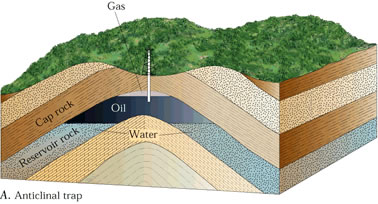Introduction of Petroleum
http://www.mpgpetroleum.com/fundamentals.html#Petroleum Traps
There are three structures can
indicate oil reservoir potentials, they are anticline, faults and
stratigraphic
trap.

Permeability
http://www.mpgpetroleum.com/fundamentals.html
Petroleum
simply
means rock oil which
is mainly the compound of hydrogen and carbon. It had been discovered
by people
long times ago and today it has become the dominant energy resource to
keep the world working. First of all to understand this issue is to
truly learn the
underground condition of oil reservoir. There are four main factors
involved in
to form a recoverable hydrocarbon formation, sources rock, reservoir
rock, trap
and cap. Oil expelled from source rocks, which were mainly shale, and
transported by gravity or pressure to those rocks having pore space,
then those
rocks confronted faults or other impermeable barriers to get trapped,
finally they
were stored and formed a recoverable oil formation.

http://www3.gov.ab.ca/env/water/GWSW/quantity/learn/evaluation/EV3_pumptest.html
Two
rock
properties should be stated
here because they are the essential elements to do everything about
petroleum
issues, they are Porosity and permeability. Porosity defined as the
ratio
between pore space and rock bulk volume. Higher porosity indicates a
great
storage potential of a rock. Permeability simply indicates how
efficient fluid
can pass through those rocks. High porosity sometimes can’t guarantee
an
optimum prospect. Because those pore spaces are not fully communicated
with
each other, only when those pores are efficiently connected, then the
oil can
be recovered from the formation.





